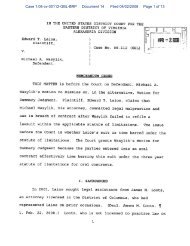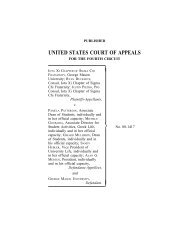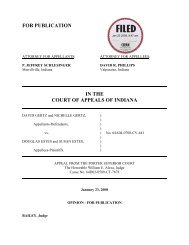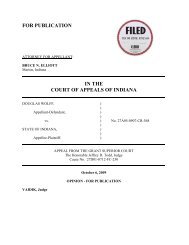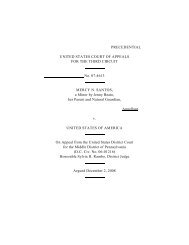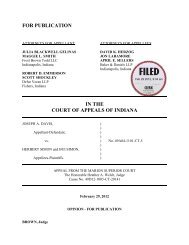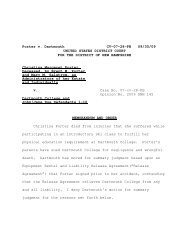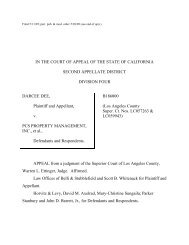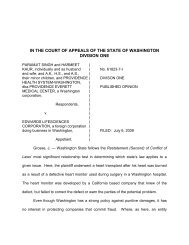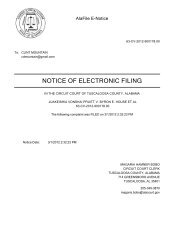Scott Pattison v. State of Indiana
Scott Pattison v. State of Indiana
Scott Pattison v. State of Indiana
You also want an ePaper? Increase the reach of your titles
YUMPU automatically turns print PDFs into web optimized ePapers that Google loves.
FOR PUBLICATION<br />
ATTORNEY FOR APPELLANT: ATTORNEYS FOR APPELLEE:<br />
STANLEY L. CAMPBELL GREGORY F. ZOELLER<br />
Fort Wayne, <strong>Indiana</strong> Attorney General <strong>of</strong> <strong>Indiana</strong><br />
<strong>Indiana</strong>polis, <strong>Indiana</strong><br />
JODI KATHRYN STEIN<br />
Deputy Attorney General<br />
<strong>Indiana</strong>polis, <strong>Indiana</strong><br />
IN THE<br />
COURT OF APPEALS OF INDIANA<br />
SCOTT PATTISON, )<br />
)<br />
Appellant-Defendant, )<br />
)<br />
vs. ) No. 85A02-1101-CR-88<br />
)<br />
STATE OF INDIANA, )<br />
)<br />
Appellee-Plaintiff. )<br />
BARTEAU, Senior Judge<br />
APPEAL FROM THE WABASH CIRCUIT COURT<br />
The Honorable Robert R. McCallen, III, Judge<br />
Cause No. 85C01-0909-MR-143<br />
DECEMBER 9, 2011<br />
OPINION - FOR PUBLICATION
STATEMENT OF THE CASE<br />
Appellant <strong>Scott</strong> <strong>Pattison</strong> appeals his conviction <strong>of</strong> murder, a felony. Ind. Code § 35-<br />
42-1-1 (2007). We affirm.<br />
ISSUES<br />
<strong>Pattison</strong> raises six issues, which we consolidate and restate as:<br />
I. Whether the trial court abused its discretion by admitting surveillance<br />
equipment and a surveillance video into evidence.<br />
II. Whether the trial court erred by allowing the jury to examine a weightlifting<br />
machine (“the machine”) during their deliberations.<br />
III. Whether the trial court abused its discretion by refusing <strong>Pattison</strong>’s request to<br />
question jurors about their examination <strong>of</strong> the machine.<br />
IV. Whether the evidence is sufficient to sustain <strong>Pattison</strong>’s conviction.<br />
FACTS AND PROCEDURAL HISTORY<br />
On July 2, 2009, at 12:14 p.m., <strong>Pattison</strong> called 911 to report that he was driving his<br />
wife, Lisa <strong>Pattison</strong>, to the hospital in Marion, <strong>Indiana</strong>, and wanted a police escort. He<br />
indicated that she was not breathing. A few minutes later, an ambulance and a police <strong>of</strong>ficer<br />
intercepted <strong>Pattison</strong>’s truck en route to the hospital. Lisa was placed in the ambulance and<br />
taken to the hospital, where she was pronounced dead.<br />
<strong>Pattison</strong>, who owned a ro<strong>of</strong>ing business, told the <strong>of</strong>ficer that he had come home from<br />
work and found Lisa’s body in their exercise room. <strong>Pattison</strong> further stated that he found Lisa<br />
lying on a weightlifting bench with the weight bar pinned across her throat. He administered<br />
CPR, and when that did not help, he put Lisa in his truck and drove to the hospital as he<br />
called 911.<br />
2
Later that day, after questioning <strong>Pattison</strong>, detectives went to <strong>Pattison</strong>’s house and<br />
searched it. In the garage, the detectives noticed a surveillance system that was connected to<br />
cameras mounted outside the house. The recording device had a slot for a DVD, but no DVD<br />
was present. The detectives assumed that without a DVD, the system had not recorded<br />
anything.<br />
On July 15, 2009, an employee <strong>of</strong> Koorsen, the company that had installed <strong>Pattison</strong>’s<br />
surveillance system, called the detectives. The employee told them that the system recorded<br />
to an internal hard drive and that the DVD slot was used only to transfer a recording from the<br />
hard drive to a DVD. Subsequently, the detectives sought and obtained a search warrant for<br />
the surveillance system and seized the system from <strong>Pattison</strong>’s house. Upon examining the<br />
system, the detectives found a recording <strong>of</strong> <strong>Pattison</strong>’s driveway from July 2, 2009. The<br />
recording showed that <strong>Pattison</strong> had returned home several hours prior to the time he told the<br />
police he had come home.<br />
A grand jury indicted <strong>Pattison</strong> for murder, and he was tried by a jury. During the trial,<br />
the court admitted into evidence the components <strong>of</strong> the surveillance system and the system’s<br />
video from July 2, 2009. In addition, the weightlifting machine was placed in the courtroom<br />
and admitted into evidence. The machine consisted <strong>of</strong> a bar on which weights could be<br />
placed, with a system <strong>of</strong> guide bars along which the weight bar could be lifted up and down.<br />
The weight bar could be locked into place at several points along the guide bars. A person<br />
could use the machine while standing or while lying on a bench under the weight bar. The<br />
machine was too large to put in the jury room, so it remained in the courtroom throughout the<br />
3
trial. During jury deliberations, jurors came into the courtroom when no one but the jury was<br />
present and examined the machine.<br />
The jury determined that <strong>Pattison</strong> was guilty <strong>of</strong> murder. After the verdict but before<br />
sentencing, <strong>Pattison</strong> filed a motion for mistrial, asserting that the jury engaged in misconduct<br />
by performing experiments on the machine during deliberations. The trial court denied his<br />
motion for mistrial and sentenced him. This appeal followed.<br />
DISCUSSION AND DECISION<br />
I. ADMISSION OF SURVEILLANCE EQUIPMENT AND THE<br />
SURVEILLANCE VIDEO<br />
A decision on the admission <strong>of</strong> evidence is subject to appellate review for abuse <strong>of</strong><br />
discretion. McHenry v. <strong>State</strong>, 820 N.E.2d 124, 128 (Ind. 2005). We reverse the trial court’s<br />
decision only when it is clearly against the logic and effect <strong>of</strong> the facts and circumstances<br />
before the court. Granger v. <strong>State</strong>, 946 N.E.2d 1209, 1213 (Ind. Ct. App. 2011). We do not<br />
reweigh the evidence, and we consider the evidence most favorable to the trial court’s ruling.<br />
<strong>Scott</strong> v. <strong>State</strong>, 883 N.E.2d 147, 152 (Ind. Ct. App. 2008).<br />
<strong>Pattison</strong> argues that the trial court violated his federal and state constitutional<br />
protections against illegal search and seizure by admitting the surveillance equipment and the<br />
surveillance video into evidence. We address each claim in turn.<br />
A. THE FOURTH AMENDMENT<br />
The Fourth Amendment to the United <strong>State</strong>s Constitution provides, “The right <strong>of</strong> the<br />
people to be secure in their persons, houses, papers, and effects, against unreasonable<br />
searches and seizures, shall not be violated, and no Warrants shall issue, but upon probable<br />
4
cause, supported by Oath or affirmation, and particularly describing the place to be searched,<br />
and the persons or things to be seized.” <strong>Pattison</strong> contends that the search warrant pursuant to<br />
which the police entered his house and seized the surveillance equipment was not supported<br />
by probable cause due to defects in the probable cause affidavit.<br />
A search warrant and its underlying probable cause affidavit must comply with the<br />
Fourth Amendment prohibition on unreasonable searches and seizures, as well as <strong>Indiana</strong><br />
constitutional and statutory law. Jackson v. <strong>State</strong>, 908 N.E.2d 1140, 1143 (Ind. 2009). The<br />
<strong>Indiana</strong> statute governing search warrants provides, in relevant part:<br />
[N]o warrant for search or arrest shall be issued until there is filed with the<br />
judge an affidavit:<br />
(1) particularly describing:<br />
(A) the house or place to be searched and the things to be searched for;<br />
or<br />
(B) particularly describing the person to be arrested;<br />
(2) alleging substantially the <strong>of</strong>fense in relation thereto and that the affiant<br />
believes and has good cause to believe that:<br />
(A) the things as are to be searched for are there concealed; or<br />
(B) the person to be arrested committed the <strong>of</strong>fense; and<br />
(3) setting forth the facts then in knowledge <strong>of</strong> the affiant or information based<br />
on hearsay, constituting the probable cause. . . .<br />
When based on hearsay, the affidavit must either:<br />
(1) contain reliable information establishing the credibility <strong>of</strong> the source and <strong>of</strong><br />
each <strong>of</strong> the declarants <strong>of</strong> the hearsay and establishing that there is a factual<br />
basis for the information furnished; or<br />
(2) contain information that establishes that the totality <strong>of</strong> the circumstances<br />
corroborates the hearsay.<br />
Ind. Code § 35-33-5-2 (2005).<br />
5
In deciding whether to issue a search warrant, “[t]he task <strong>of</strong> the issuing magistrate is<br />
simply to make a practical, common-sense decision whether, given all the circumstances set<br />
forth in the affidavit . . . there is a fair probability that contraband or evidence <strong>of</strong> a crime will<br />
be found in a particular place.” Jackson, 908 N.E.2d at 1142 (quoting Illinois v. Gates, 462<br />
U.S. 213, 238, 103 S. Ct. 2317, 76 L. Ed. 2d 527 (1983)). Probable cause is a fluid concept,<br />
which is decided based on the facts <strong>of</strong> each case. Cheever-Ortiz v. <strong>State</strong>, 825 N.E.2d 867,<br />
872 (Ind. Ct. App. 2005). The duty <strong>of</strong> the reviewing court is to determine whether the<br />
magistrate had a substantial basis for concluding that probable cause existed. Id. at 871. A<br />
substantial basis requires the reviewing court, with significant deference to the magistrate’s<br />
determination, to focus on whether reasonable inferences drawn from the totality <strong>of</strong> the<br />
evidence support the determination <strong>of</strong> probable cause. Id.<br />
<strong>Pattison</strong> argues that the probable cause affidavit was invalid because it was based on<br />
stale information. As a general rule, stale information will not support a finding <strong>of</strong> probable<br />
cause. Shell v. <strong>State</strong>, 927 N.E.2d 413, 418 (Ind. Ct. App. 2010). Our courts have not<br />
established a bright-line rule regarding the amount <strong>of</strong> time that may elapse between obtaining<br />
the facts upon which the search warrant is based and the issuance <strong>of</strong> the warrant. Id. Instead,<br />
whether the information is tainted by staleness must be determined by the facts and<br />
circumstances <strong>of</strong> each particular case. Id.<br />
In this case, Detective Michael Davis stated in the probable cause affidavit that in<br />
2001, the Wabash County Sheriff’s Department received a report that <strong>Pattison</strong> had asked a<br />
person to kill Lisa. Although this information is relevant to the type <strong>of</strong> crime at issue here,<br />
6
the report is at least eight years old and is too stale to give rise to more than a mere suspicion.<br />
Similarly, Davis’ affidavit included a statement by Leah Frazier, a friend <strong>of</strong> Lisa’s. Frazier<br />
told Davis that Lisa had told Frazier “6-8 months ago” that Lisa had put internet tracking<br />
s<strong>of</strong>tware on <strong>Pattison</strong>’s computer because he had been having an affair. Appellant’s App. p.<br />
19. Frazier further related that “as <strong>of</strong> January 2009,” the program was still on his computer.<br />
Id. This information may shed some light on <strong>Pattison</strong>’s motives but is also too remote in<br />
time to give rise to more than a mere suspicion <strong>of</strong> wrongdoing.<br />
The probable cause affidavit further describes Davis’ interview with Christine Smith,<br />
Lisa’s sister. Smith told Davis that two years ago, <strong>Pattison</strong> removed money from <strong>Pattison</strong><br />
and Lisa’s retirement accounts. This information is unrelated to the crime at issue here and is<br />
too old to support a finding <strong>of</strong> probable cause.<br />
Davis’s affidavit further states that Marie Lloyd had spoken with Sergeant Tyler<br />
Guinen and told him that in December 2008, <strong>Pattison</strong> had asked Lloyd to do an appraisal <strong>of</strong><br />
<strong>Pattison</strong> and Lisa’s house, without Lisa’s knowledge, because <strong>Pattison</strong> was contemplating a<br />
divorce. Lloyd’s information is also too remote in time to provide more than a mere<br />
suspicion that <strong>Pattison</strong> and Lisa were experiencing marital difficulties.<br />
We conclude that the portions <strong>of</strong> the affidavit discussed in the preceding paragraphs<br />
are stale and cannot provide a basis for the trial court’s probable cause determination. The<br />
remaining portions <strong>of</strong> the affidavit are not stale.<br />
Next, <strong>Pattison</strong> argues that the probable cause affidavit is invalid because it is based on<br />
uncorroborated hearsay. Uncorroborated hearsay from an informant whose credibility is<br />
7
unknown, standing alone, cannot provide probable cause to issue a search warrant. <strong>State</strong> v.<br />
Foy, 862 N.E.2d 1219, 1225 (Ind. Ct. App. 2007), trans. denied. As is noted above, when a<br />
probable cause affidavit includes hearsay information, the affidavit must either: (1) contain<br />
reliable information establishing the credibility <strong>of</strong> the source and <strong>of</strong> each <strong>of</strong> the declarants <strong>of</strong><br />
the hearsay and establishing that there is a factual basis for the information furnished; or (2)<br />
contain information that establishes that the totality <strong>of</strong> the circumstances corroborates the<br />
hearsay. Ind. Code § 35-33-5-2(b).<br />
In this case, Davis’ affidavit includes further information provided by Lisa’s sister,<br />
Smith. Smith stated that she was <strong>Pattison</strong> and Lisa’s financial advisor, and that<br />
approximately a month before Lisa’s death, Lisa changed the beneficiary <strong>of</strong> her life insurance<br />
policy from her son and <strong>Pattison</strong>, as joint beneficiaries, to her son alone. Smith did not give<br />
any documents to Davis to support her assertion, and the affidavit lacks any independent<br />
corroboration <strong>of</strong> Smith’s credibility. Consequently, Smith’s assertions are uncorroborated<br />
hearsay and cannot support the probable cause determination.<br />
Next, the probable cause affidavit described <strong>Pattison</strong>’s call to 911, in which <strong>Pattison</strong><br />
told the dispatcher that he had found Lisa under a set <strong>of</strong> weights and that her face was blue.<br />
<strong>Pattison</strong> concedes that this is “accurate information” despite being hearsay. Appellant’s Br.<br />
p. 18. The affidavit also discusses the results <strong>of</strong> an autopsy on Lisa. Dr. <strong>Scott</strong> Wagner, who<br />
performed the autopsy, found “unexplained Peticiae [sic]” on Lisa’s back and the back <strong>of</strong> her<br />
neck. Appellant’s App. p. 19. Dr. Wagner suggested that the presence <strong>of</strong> “Peticiae [sic]”<br />
was inconsistent with <strong>Pattison</strong>’s description <strong>of</strong> finding Lisa with weights on her throat. Dr.<br />
8
Wagner’s statements are hearsay, but his statements are based on personal knowledge and are<br />
therefore credible. See Foy, 862 N.E.2d at 1226 (determining that emergency medical<br />
personnel’s hearsay statements were reliable because they were based on personal<br />
observation).<br />
Next, Davis stated in his affidavit that when he interviewed <strong>Pattison</strong> on July 2, 2009,<br />
<strong>Pattison</strong> conceded that he and Lisa were having marital problems because he had been having<br />
an affair. <strong>Pattison</strong> further conceded that he had filed for divorce earlier in 2009, although he<br />
asserted that he later decided to try to reconcile with Lisa. <strong>Pattison</strong>’s statements are hearsay,<br />
but the police corroborated <strong>Pattison</strong>’s statements by: (1) examining court records to confirm<br />
<strong>Pattison</strong>’s divorce filing; and (2) finding a letter in <strong>Pattison</strong> and Lisa’s house on July 3, 2009,<br />
apparently in Lisa’s handwriting, that referenced marital discord.<br />
Davis also stated in his probable cause affidavit that on July 15, 2009, he was<br />
contacted by an employee <strong>of</strong> Koorsen, who told Smith “that <strong>Scott</strong> <strong>Pattison</strong> had called and<br />
asked how to delete the video from his security system.” Appellant’s App. p. 20. <strong>Pattison</strong><br />
correctly notes that this statement is hearsay, and the affidavit provides no corroboration for<br />
that statement. Therefore, we conclude that the statement does not support a finding <strong>of</strong><br />
probable cause. Nevertheless, the Koorsen employee also told Davis that the surveillance<br />
system recorded to a hard drive and that a DVD was only necessary to copy saved data. In<br />
the affidavit, Davis corroborated this statement by noting that he had inspected the system<br />
during his previous search <strong>of</strong> the house and that he had noticed the absence <strong>of</strong> a DVD. Thus,<br />
one may reasonably infer from the Koorsen employee’s statement that the surveillance<br />
9
system may have had data from the date <strong>of</strong> Lisa’s death.<br />
In summary, setting aside stale information and uncorroborated hearsay, the probable<br />
cause affidavit indicates that an autopsy produced evidence that conflicted with <strong>Pattison</strong>’s<br />
explanation for Lisa’s death, that <strong>Pattison</strong> and Lisa were having marital problems to the point<br />
that <strong>Pattison</strong> had filed for divorce, and that a camera surveillance system may have recorded<br />
footage outside <strong>of</strong> the <strong>Pattison</strong>s’ home on the day that Lisa died. We acknowledge that this is<br />
a close case. However, in determining whether an affidavit provided probable cause for the<br />
issuance <strong>of</strong> a search warrant, doubtful cases are to be resolved in favor <strong>of</strong> upholding the<br />
warrant. Mehring v. <strong>State</strong>, 884 N.E.2d 371, 377 (Ind. Ct. App. 2008), trans. denied. Thus,<br />
reasonable inferences drawn from the totality <strong>of</strong> the evidence indicate that there was a fair<br />
probability that evidence <strong>of</strong> murder would be found in the surveillance system, and the trial<br />
court had a reasonable basis to issue the search warrant. The admission <strong>of</strong> the surveillance<br />
system equipment and video into evidence did not violate the Fourth Amendment.<br />
provides:<br />
B. ARTICLE 1, SECTION 11<br />
Article 1, Section 11 <strong>of</strong> the <strong>Indiana</strong> Constitution governs search and seizure, and it<br />
The right <strong>of</strong> the people to be secure in their persons, houses, papers, and<br />
effects, against unreasonable search or seizure, shall not be violated; and no<br />
warrant shall issue, but upon probable cause, supported by oath or affirmation,<br />
and particularly describing the place to be searched, and the person or thing to<br />
be seized.<br />
As is the case with the Fourth Amendment, the principles <strong>of</strong> Article 1, Section 11 are<br />
codified in <strong>Indiana</strong> Code section 35-33-5-2, set forth above. See Foy, 862 N.E.2d at 1225.<br />
10
In this case, <strong>Pattison</strong> argues that the probable cause affidavit does not support the<br />
issuance <strong>of</strong> the search warrant and subsequent seizure <strong>of</strong> his surveillance system because the<br />
affidavit consists <strong>of</strong> uncorroborated hearsay. As is discussed above, the corroborated hearsay<br />
and other valid statements in the affidavit establish that the results <strong>of</strong> the autopsy were<br />
inconsistent with <strong>Pattison</strong>’s account <strong>of</strong> Lisa’s death, that he and Lisa were experiencing<br />
marital problems so severe that <strong>Pattison</strong> filed for divorce, and that a surveillance system at<br />
the house may have captured footage <strong>of</strong> <strong>Pattison</strong> and Lisa’s home on the day <strong>of</strong> her death.<br />
We conclude that the affidavit established a substantial basis for the issuance <strong>of</strong> the search<br />
warrant, and the admission <strong>of</strong> the surveillance system and surveillance video into evidence<br />
did not violate Article 1, Section 11 <strong>of</strong> the <strong>Indiana</strong> Constitution. See Foy, 862 N.E.2d at<br />
1226 (determining that there was a substantial basis to conclude that probable cause existed<br />
for a search warrant where <strong>of</strong>ficers’ and emergency medical personnel’s hearsay statements<br />
in a probable cause affidavit were sufficiently trustworthy). Therefore, in the absence <strong>of</strong> a<br />
violation <strong>of</strong> the Fourth Amendment or Article 1, Section 11, we find no abuse <strong>of</strong> discretion in<br />
the trial court’s admission <strong>of</strong> those exhibits into evidence.<br />
II. THE JURORS’ EXAMINATION OF THE WEIGHTLIFTING MACHINE<br />
<strong>Pattison</strong> argues that the trial court should not have allowed the jury to return to the<br />
courtroom during deliberations to examine the machine. Specifically, <strong>Pattison</strong> contends: (1)<br />
<strong>Pattison</strong> should have been given notice and an opportunity to be present for the jury’s<br />
examination <strong>of</strong> the machine; and (2) the jurors engaged in inappropriate experiments with the<br />
11
machine.<br />
Before we address <strong>Pattison</strong>’s contentions, the <strong>State</strong> argues that <strong>Pattison</strong> waived them<br />
because he failed to timely object at trial to the jury’s examination <strong>of</strong> the machine. As a<br />
general rule, the failure to object at trial results in a waiver <strong>of</strong> the issue on appeal. Benson v.<br />
<strong>State</strong>, 762 N.E.2d 748, 755 (Ind. 2002).<br />
In this case, at one point during the presentation <strong>of</strong> evidence, a juror asked to examine<br />
the machine. The trial court stated:<br />
. . . I would tell you with respect to the question you had about the equipment,<br />
this equipment’s gonna stay up and assembled throughout the duration <strong>of</strong> the<br />
trial and so if during deliberations you feel you want to see it, I’ll clear the<br />
courtroom and you will be the only ones in here and you can check it as you<br />
desire. Just like any other evidence. Okay?<br />
Tr. p. 523. <strong>Pattison</strong> did not object to the trial court’s plan.<br />
In response to the <strong>State</strong>’s argument, <strong>Pattison</strong> contends that he had no objection to<br />
allowing the jurors to examine the machine during their deliberations, but he asserts that he<br />
should have been given notice and an opportunity to be present for the examination. When<br />
the trial court informed the jury that it would be given an opportunity to examine the machine<br />
during deliberations, and that the jurors would be “the only ones” in the room at that time,<br />
<strong>Pattison</strong> had an opportunity to object to his exclusion from the examination and did not take<br />
that opportunity. We conclude that he waived the issue <strong>of</strong> notice and an opportunity to be<br />
present during deliberations. However, as to <strong>Pattison</strong>’s claim that the jury’s examination <strong>of</strong><br />
the machine was, in substance, an inappropriate experiment, he could not have objected to<br />
the jury’s conduct before the conduct occurred. Consequently, we deem that issue to be<br />
12
preserved for appellate review.<br />
An experiment by the jury is improper where it amounts to additional evidence<br />
supplementary to that introduced during the trial. Bradford v. <strong>State</strong>, 675 N.E.2d 296, 304<br />
(Ind. 1996). In Bradford, the defendant was charged with arson and murder. During the<br />
presentation <strong>of</strong> the evidence, a detective testified as to experiments he had conducted to<br />
establish whether the defendant could have committed the <strong>of</strong>fenses in the time allowed.<br />
Next, the jury was taken to the crime scene and permitted to view it. Later, during<br />
deliberations, the jury requested and received permission to return to the crime scene, where<br />
they performed experiments as to how fast a person could pour gasoline out <strong>of</strong> a can and<br />
crawl through the house. Our Supreme Court determined that the jury’s actions were in<br />
keeping with the evidence presented and were not improper. Id.<br />
In this case, the <strong>State</strong> assembled the machine in the courtroom. The machine was<br />
entered into evidence as <strong>State</strong>’s Exhibit 17 without objection. During the testimony <strong>of</strong> Laurel<br />
Jensen, who worked for the company that manufactured the machine, the jury was permitted<br />
to leave the jury box and gather around the machine. Jensen explained how it worked and<br />
pointed out its parts and features. Later, Detective Jason Page testified about experiments he<br />
had performed on the machine during his investigation. During his testimony, Page lay down<br />
on the machine and demonstrated for the jury how it functioned. Among other features, he<br />
demonstrated how a user could lock the weight bar into place on the guide bars to prevent it<br />
from falling on the user. Next, during the cross-examination <strong>of</strong> Dr. Greg Davis, the<br />
prosecutor had a detective lie on the bench, and he straddled the detective while questioning<br />
13
Dr. Davis. The prosecutor, while grabbing the detective’s wrists, asked Dr. Davis if a person<br />
could keep another person who was using the machine from locking the weight bar into place<br />
under those circumstances. The prosecutor also asked Dr. Davis to estimate how quickly a<br />
person’s breathing would be impeded if the weight bar were laying on his or her neck and<br />
another person sat on his or her abdomen.<br />
According to a post-trial newspaper article in which one <strong>of</strong> the jurors gave an<br />
interview, 1 the jurors returned to the courtroom during their deliberations to experiment with<br />
the machine. A female juror lay on the weight bench and tried to get out from under the<br />
weight bar. Next, the same juror tried to get out from under the weights while another juror<br />
sat on her and held her wrists. As was the case in Bradford, the jurors in this case acted in<br />
keeping with the testimony presented at trial. Furthermore, in the current case the jurors<br />
were examining a properly admitted exhibit. We conclude that the jury’s actions were not<br />
improper. See Kennedy v. <strong>State</strong>, 578 N.E.2d 633, 641 (Ind. 1991) (finding no error where<br />
two shirts had been admitted into evidence and two jurors <strong>of</strong> height and build similar to the<br />
defendant attempted to put them on during deliberations).<br />
III. DENIAL OF PATTISON’S REQUEST TO QUESTION THE JURY<br />
In his motion for mistrial, <strong>Pattison</strong> asked the Court to hold a hearing and require jurors<br />
to appear for questioning about their experiments with the machine. The trial court denied<br />
<strong>Pattison</strong>’s request. Granting or denying a motion for a mistrial is within the discretion <strong>of</strong> the<br />
1 The trial court assumed the truth <strong>of</strong> the factual representations in the article for the purpose <strong>of</strong> ruling on<br />
<strong>Pattison</strong>’s motion for mistrial. We likewise assume the truth <strong>of</strong> the representations in the article for purposes <strong>of</strong><br />
this appeal.<br />
14
trial court. Treadway v. <strong>State</strong>, 924 N.E.2d 621, 628 (Ind. 2010). We review the trial court’s<br />
decision solely for abuse <strong>of</strong> discretion. Id.<br />
As a general rule, a jury’s verdict may not be impeached by evidence from the jurors<br />
who returned it. Hape v. <strong>State</strong>, 903 N.E.2d 977, 987 (Ind. Ct. App. 2009), trans. denied.<br />
Parties may question jurors as to the validity <strong>of</strong> a verdict in limited circumstances, as follows:<br />
Upon an inquiry into the validity <strong>of</strong> a verdict or indictment, a juror may not<br />
testify as to any matter or statement occurring during the course <strong>of</strong> the jury’s<br />
deliberations or to the effect <strong>of</strong> anything upon that or any other juror’s mind or<br />
emotions as influencing the juror to assent to or dissent from the verdict or<br />
indictment or concerning the juror’s mental processes in connection therewith,<br />
except that a juror may testify (1) to drug or alcohol use by any juror, (2) on<br />
the question <strong>of</strong> whether extraneous prejudicial information was improperly<br />
brought to the jury’s attention or (3) whether any outside influence was<br />
improperly brought to bear upon any juror. . . .<br />
Ind. Evidence Rule 606(B). <strong>Pattison</strong> argues that the jurors should have been questioned to<br />
establish whether their experiments with the machine constituted extraneous prejudicial<br />
information. We have established above that the jury’s examination <strong>of</strong> the machine during<br />
deliberation was not extraneous, additional evidence, but rather was a permissible<br />
consideration <strong>of</strong> the evidence presented at trial. Therefore, the trial court did not abuse its<br />
discretion by denying <strong>Pattison</strong>’s request for an evidentiary hearing to question jurors. See<br />
Hape, 903 N.E.2d at 988 (determining that the trial court properly denied the defendant’s<br />
request to question jurors about text messages the jurors found on a cell phone during<br />
deliberations because the cell phone was properly admitted into evidence, and as a result the<br />
messages were not extraneous information).<br />
15
IV. SUFFICIENCY OF THE EVIDENCE<br />
When an appellant challenges the sufficiency <strong>of</strong> the evidence supporting a conviction,<br />
we do not reweigh the evidence or judge the credibility <strong>of</strong> the witnesses. Joslyn v. <strong>State</strong>, 942<br />
N.E.2d 809, 811 (Ind. 2011). We consider only the probative evidence and reasonable<br />
inferences drawn from the evidence that support the verdict. Id. We will affirm if the<br />
probative evidence and reasonable inferences drawn from the evidence could have allowed a<br />
reasonable trier <strong>of</strong> fact to find the defendant guilty beyond a reasonable doubt. Id. A<br />
conviction may be based on circumstantial evidence alone so long as there are reasonable<br />
inferences enabling the factfinder to find the defendant guilty beyond a reasonable doubt.<br />
Long v. <strong>State</strong>, 935 N.E.2d 194, 198 (Ind. Ct. App. 2010), trans. denied.<br />
In order to convict <strong>Pattison</strong> <strong>of</strong> murder as charged, the <strong>State</strong> was required to prove<br />
beyond a reasonable doubt that (1) <strong>Pattison</strong> (2) knowingly or intentionally (3) killed (4) Lisa<br />
<strong>Pattison</strong>. See Ind. Code § 35-42-1-1; Appellant’s App. p. 22.<br />
In this case, ample evidence established that <strong>Pattison</strong> and Lisa’s marriage was under<br />
severe stress. In 2008, Lisa discovered that <strong>Pattison</strong> had been having an affair with Stacy<br />
Henderson. <strong>Pattison</strong> stopped communicating with Henderson for several months.<br />
Nevertheless, <strong>Pattison</strong> and Henderson resumed their affair and communicated frequently by<br />
text and telephone, including during the days leading up to and following Lisa’s death. On<br />
the day <strong>of</strong> Lisa’s death, <strong>Pattison</strong> told a detective that he had ended the affair because he did<br />
not want to be with his mistress anymore. Nevertheless, at that time he refused to provide<br />
Henderson’s name to the police. In addition, <strong>Pattison</strong> subsequently told a person from whom<br />
16
he purchased ro<strong>of</strong>ing supplies that he thought he and Henderson would be together someday.<br />
<strong>Pattison</strong> and Henderson continued to communicate even after <strong>Pattison</strong> was charged with<br />
murder and incarcerated.<br />
<strong>Pattison</strong> filed for divorce in March 2009. At the same time, <strong>Pattison</strong> wanted to avoid<br />
the financial consequences <strong>of</strong> a divorce. On November 19, 2008, <strong>Pattison</strong> called real estate<br />
appraiser Marie Lloyd. He asked her about performing an appraisal <strong>of</strong> the marital residence,<br />
stating he “didn’t know if he could afford a divorce.” Tr. p. 884. Furthermore, in February<br />
2009, a month before filing for divorce, <strong>Pattison</strong> told Lisa’s friend Leah Frazier that “he<br />
wasn’t going to give her 50% <strong>of</strong> his business.” Id. at 983. A week before Lisa died, <strong>Pattison</strong><br />
told an employee that he and Lisa were not getting along and that it was difficult to have her<br />
living there “while the divorce was being finalized.” Id. at 906. In addition, Dillon McCoy,<br />
who was Lisa’s son and <strong>Pattison</strong>’s stepson, believed that the divorce was going forward<br />
because <strong>Pattison</strong> and Lisa had put away their marriage photos and the house was up for sale.<br />
At the time <strong>of</strong> Lisa’s death, Henderson also believed that <strong>Pattison</strong> intended to divorce Lisa.<br />
<strong>Pattison</strong> told <strong>of</strong>ficers that on the day <strong>of</strong> Lisa’s death, he came home at 11:30 a.m.,<br />
entered the house at 11:45 a.m., and discovered Lisa in the exercise room. <strong>Pattison</strong> also told<br />
McCoy that he returned home between 11:30 and 11:45 a.m. However, the surveillance<br />
video showed that <strong>Pattison</strong> had returned home at 8:32 a.m. The cameras also recorded him<br />
entering and exiting the house and walking around outside <strong>of</strong> the house at 9:56 a.m., 10:03<br />
a.m., 10:07 a.m., and 11:38 a.m. Furthermore, in the video <strong>Pattison</strong> was wearing shorts at<br />
one point and pants at another point. In addition, phone records indicate that he made several<br />
17
calls between 9:57 a.m. and 12:14 p.m. while at or near the house. A medical examiner, Dr.<br />
<strong>Scott</strong> Wagner, determined that Lisa had been dead for two to three hours when she was<br />
<strong>of</strong>ficially pronounced dead at the hospital. Id. at 819.<br />
Regarding the weightlifting machine, <strong>Pattison</strong> told detectives that he and Lisa had<br />
used it “millions <strong>of</strong> times before.” Id. at 356. McCoy only saw Lisa use the machine once,<br />
when <strong>Pattison</strong> was spotting her. McCoy stated that Lisa preferred to work out with smaller<br />
hand weights when she used the treadmill or step machine. Furthermore, when a detective<br />
told <strong>Pattison</strong> that they found that the weightlifting machine was set at 140 pounds, <strong>Pattison</strong><br />
told him that 140 pounds “was probably about the maximum she’s done.” Id. at 398. McCoy<br />
disputed <strong>Pattison</strong>’s assessment, stating “she wasn’t like a woman that could bench like thirty-<br />
five pounds on each side.” Id. at 697. Laurel Jensen inspected the machine after Lisa’s death<br />
and determined that it had not seen a lot <strong>of</strong> use, judging by a lack <strong>of</strong> wear and tear. Detective<br />
Jason Page found that the machine had no mechanical failures that he could detect.<br />
Dr. Wagner noted that Lisa’s neck injury was not consistent with the weight bar<br />
falling on her neck at a high rate <strong>of</strong> speed, because her larynx, trachea, and voice box had<br />
been compressed but not crushed. To the contrary, in Dr. Wagner’s opinion the weight bar<br />
could not have fallen more than “an inch or two” without resulting in far greater injuries than<br />
were actually present. Id. at 817. Consequently, Dr. Wagner concluded that Lisa’s death was<br />
caused by asphyxiation due to compression <strong>of</strong> the weight on her neck. Dr. Wagner also<br />
noted the presence <strong>of</strong> petechiae, or ruptured blood vessels caused by pressure, on Lisa’s back<br />
and concluded that they were not caused by the weight bar. Instead, the petechiae were<br />
18
consistent with a person straddling Lisa’s torso or with a great weight being placed on her<br />
torso.<br />
The day after Lisa’s murder, <strong>Pattison</strong> asked Lisa’s sister, Christine Smith, about Lisa’s<br />
life insurance policy. He was “stunned” to learn that, as far as Smith knew, Lisa had recently<br />
named McCoy the sole beneficiary <strong>of</strong> her policy. Id. at 940. On the same day, <strong>Pattison</strong><br />
texted Henderson and asked about Henderson’s husband, stating: “So is he trying to get<br />
closer to u, since im [sic] free Now.?? [sic] That’s a sick whay [sic] to say it.” Trial<br />
Notebook, Item 12, p. 3.<br />
This circumstantial evidence is sufficient to establish beyond a reasonable doubt that<br />
<strong>Pattison</strong> killed Lisa. <strong>Pattison</strong> points to evidence that the weightlifting machine’s bench may<br />
have been inadvertently positioned so that the bar came down on Lisa’s neck rather than her<br />
chest. He also contends that Lisa may have inadvertently overdosed on her prescription<br />
medications, which could have caused a cardiac problem that accidentally resulted in her<br />
death while lifting weights. These arguments amount to a request to reweigh the evidence,<br />
which we cannot do.<br />
CONCLUSION<br />
For the reasons stated above, we affirm the judgment <strong>of</strong> the trial court.<br />
Affirmed.<br />
RILEY, J., and MAY, J., concur .<br />
19



